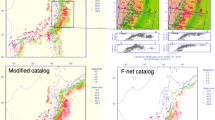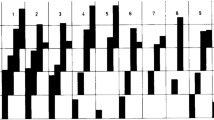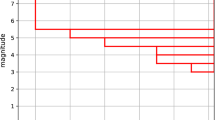Abstract
The epidemic type aftershock sequence (ETAS) statistical model of aftershock seismicity combines various earthquake scaling relations to produce synthetic earthquake catalogs, or estimates of aftershock seismicity rates, based on recent earthquake activity. One challenge to ETAS-based hazard assessment is the large number of free parameters involved. In this paper, we introduce an approach to constrain this parameter space from canonical scaling relations, empirical observations, and fundamental physics. We show that ETAS parameters can be estimated as a function of an earthquake’s magnitude m based on the finite temporal and spatial extents of the rupture area. This approach facilitates fast ETAS-based estimates of seismicity from large “seed” catalogs, and it is particularly well suited to web-based deployment and otherwise automated implementations. It constitutes a significant improvement over contemporary ETAS by mitigating variability related to instrumentation and subjective catalog selection.







Similar content being viewed by others
References
Aki K (1981) A probabilistic synthesis of precursory phenomena, in: Earthquake Prediction, An International Review, edited by Simpson, D. W. and Richards, P. G., Maurice Ewing Series 4, pp. 566–574, American Geophysical Union
Båth M (1965) Lateral inhomogeneities in the upper mantle, Tectonophysics 2:483–514
Enescu B, Mori J, Miyazawa M, Kano Y (2009) “Omori-Utsu law c-values associated with recent moderate earthquakes in Japan”. Bull. Seismol. Soc. Am 99:884–891. doi:10.1785/0120080211
Felzer K., Brodsky E (2006) Decay of aftershock density with distance indicates triggering by dynamic stress, Nature 441:735–738. doi:10.1038/nature04799
Gutenberg B., Richter CF (1954) Seismicity of the Earth and Associated Phenomenon, Princeton Univ. Press, 2nd edn
Helmstetter A (2003) Is Earthquake Triggering Driven by Small EArthquakes?. Physical Review Letters 91:058 501–1:4. doi:10.1103/PhysRevLett.91.058501
Holliday JR, Yoder MR (2014) A Model for Saturated Power Laws in Geophysical Systems. Pure Ap. Geophys., (under review)
Holliday JR, Rundle JB, Tiampo KF, Turcotte DL (2006) Using earthquake intensities to forecast earthquake occurence times. Nonlin. Processes Geophys 13:585–593. http://www.nonlin-processes-geophys.net/13/585/2006
Holliday JR, Chen C-c, Tiampo KF, Rundle JB, Turcotte DL, Donnellan A (2007) A RELM Earthquake Forecast Based on Pattern Informatics, Bull. Seis. Soc. Am 78:87–93. doi:10.1785/gssrl.78.1.87
Holliday JR, Turcotte DL, Rundle JB (2008a) Self-similar branching of aftershock sequences. Physica A 387:933–943
Holliday JR, Turcotte DL, Rundle JB (2008b) A review of earthquake statistics: Fault and seismicity-based models. ETAS and BASS, Pure Ap. Geophys 165:1003–1024
Jones E, Oliphant T, Peterson P, et al (2009) SciPy: Open source scientific tools for Python, Software. http://www.scipy.org
Kagan Y (2002) Aftershock Zone Scaling, Bull. Seismol. Soc. Am 92:641–655. doi:10.1785/0120010172
Karney C (2012) GeographycLib (C++/Python), http://geographiclib.sourceforge.net/, http://geographiclib.sourceforge.net/
Newman WI, Turcotte DL, Malamud BD (2012) Emergence of patterns in random processes, Phys. Rev. E 86:026–103. doi:10.1103/PhysRevE.86.026103
Ogata Y (1988) Statistical models for earthquake occurrences and residual analysis for point processes. J. Am. Stat. Assoc 83:9–27
Ogata Y, Zhuang J (2005) Space-time ETAS models and an improved extension, Tectonophysics 413:13–23, doi:10.1016/j.tecto.2005.10.016
Omori F (1894) On the aftershocks of earthquakes, Journal of the College of Science. Imperial University of Tokyo 7:111–200
Pacheco JF, Scholz CH, Sykes LR (1992) Changes in frequency-size relationship from small to large earthquakes. Nature 355:71–73
Reasenberg PA, Jones LM (1989) Earthquake Hazard After a Mainshock in California. Science 243:1173–1176. doi:10.1126/science.243.4895.1173
Rundle JB (1989) Derivation of the Complete Gutenberg-Richter Magnitude-Frequency Relation Using the Principle of Scale Invariance. J. Geophys. Res 94:12,337–12,342
Shcherbakov R., Turcotte DL (2004a) A damage mechanics model for aftershocks, Pure Ap. Geophys 161:2379–2391
Shcherbakov R, Turcotte DL (2004b) A modified form of Båth’s law, Bull. Seis. Soc. Am, 94, 1968–1975. doi:10.1785/012003162
Shcherbakov R, Turcotte DL, Rundle JB (2004) A generalized Omori’s law for earthquake aftershock decay. Geophys. Res. Lett 31:L11 613
Shcherbakov R, Turcotte DL, Rundle JB (2006) Scaling properties of the Parkfield aftershock sequence, Bull. Seis. Soc. Am 96:S376–S384. doi:10.1785/0120050815
Tahir M, Grasso J-R, Amorese D (2012) The largest aftershock: How strong, how far away, how delayed?. Geophysical Research Letters 39:L04–301 doi:10.1029/2011GL050604
Tiampo K, Rundle J, Klein W, Holliday J (2006) Forecasting rupture dimension using the pattern informatics technique. Tectonophysics 424:367–376. doi:10.1016/j.tecto.2006.03.047
Turcotte DL, Holliday JR, Rundle JB (2007) BASS. an alternative to ETAS, Geophys. Res. Lett 34:L12 303
Utsu T (1984) Estimation of parameters for recurrence models of earthquakes. Earthquake Res. Insti. Univ. Tokyo 59:53–66
Van Aalsburg J, Turcotte DL, Newman WI, Rundle JB (2010) Record-breaking earthquakes. Bull. Seimol. Soc. Am 100:1800–1805. doi:10.1785/0120090015
Vidale JE, Houston H (1993) mechanismsThe depth dependence of earthquake duration and implecations for rupture . Nature 365:45–47
Yoder MR (2011) Record-breaking earthquake precursors, Ph.D. thesis, University of California Davis
Yoder MR, Turcotte DL, Rundle JB (2010) Record-breaking earthquake intervals in a global catalog and an aftershock sequence. Nonlin. Processes Geophys 17:169–176
Yoder MR, Van Aalsburg J, Turcotte DL, Abaimov S, Rundle JB (2011) Statistical Variability and Tokunaga Branching of Aftershock Sequences Utilizing BASS Model Simulations, Pure and Applied Geophysics pp. 1–17. doi:10.1007/s00024-011-0411-2
Yoder MR, Holliday JR, Turcotte DL, Rundle JB (2012) A geometrical frequency-magnitude scaling transition: Measuring b = 1.5 for large earthquakes, Tectonophys 532–535:157–174. doi:10.1016/j.tecto.2012.01.034
Yoder MR, Rundle J, Turcotte DL (2014a) Record-breaking intervals: Detecting rate trends in self-similar earthquake sequences, Pure Ap. Geophys (under revision)
Yoder MR, Turcotte DL, Rundle JB (2014b) Scaling constraints to detect pre-seismic acceleration: A record-breaking framework for earthquake predictability. Tectonophys., (under revision)
Acknowledgments
This work has been supported by JPL Subcontract 1291967, and NASA Grant NNX08AF69G.
Author information
Authors and Affiliations
Corresponding author
Rights and permissions
About this article
Cite this article
Yoder, M.R., Rundle, J.B. & Glasscoe, M.T. Near-Field ETAS Constraints and Applications to Seismic Hazard Assessment. Pure Appl. Geophys. 172, 2277–2293 (2015). https://doi.org/10.1007/s00024-014-0785-z
Received:
Revised:
Accepted:
Published:
Issue Date:
DOI: https://doi.org/10.1007/s00024-014-0785-z




